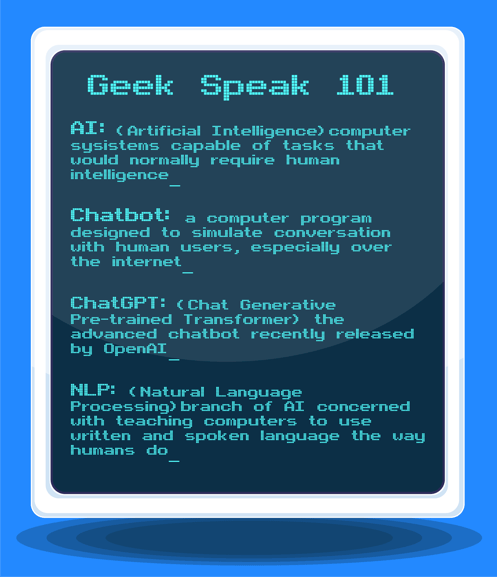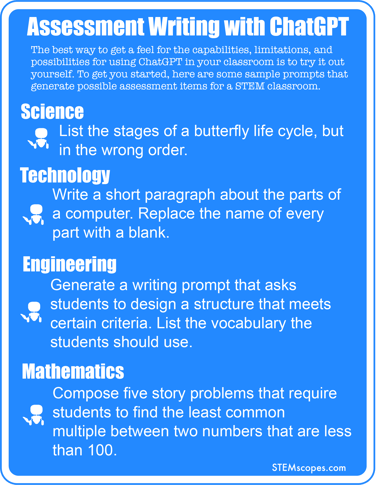
5 Easy Math Engagement Strategies for the Classroom
The news headlines are daunting. Math scores are down. School districts are scrambling to turn things around. And...
STEMscopes Staff | Published February 24, 2023
ChatGPT, a language model that uses deep learning techniques to generate human-like responses, has garnered significant attention for its potential applications in education.
This AI-powered technology has been hailed as a game-changer for the education industry. Its ability to support personalized learning experiences, facilitate research and knowledge acquisition, and automate testing and assessment.
However, as with any emerging technology, there are concerns around the accuracy and biases of ChatGPT's responses, as well as potential privacy and ethical implications of using AI in education.
In this article, we will explore the potential of ChatGPT in education, as well as its limitations and risks, to better understand the impact of AI on the future of learning.

Artificial intelligence (AI) is usually defined as the theory and creation of computer systems capable of performing tasks that would typically require human intelligence.
In other words, getting computers to do things we used to assume computers would never be able to do or never be good at, such as recognizing objects visually, understanding and producing speech, and creating original content.
In recent years the initial technical difficulties of getting computers to accomplish these tasks have been gradually overcome, and the pace of progress is increasing.
As the technology of AI has improved, innovators have explored new ways to apply it to education.
One area of innovation is in educational assessment. Versions of AI that can process visual input can optically “read” a handwritten math equation and grade it.
Similarly, speech recognition has improved to the point that AI can evaluate spoken responses. In addition, when these systems integrate machine learning, they can improve their ability to do these assessments over time.
 As computers have become faster and more powerful, they still seem to lag in certain areas, such as language.
As computers have become faster and more powerful, they still seem to lag in certain areas, such as language.
If you're like me, you’ve been a sci-fi fan for years and probably wondered, “Where are the computers we can talk to?”
We probably all know the frustration of trying to get Alexa to follow a simple command or have our patience interacting with the robot on the other end of a phone call.
Because the human brain is hard-wired for language, we often don’t realize how incredibly complex an enterprise it is.
Natural Language Processing (NLP), teaching computers to use written and spoken language the way humans do, began soon after the first computers were built.
The complexity of the task, however, has stymied professionals for decades. Real progress has been made in recent years, though, as the release of ChatGPT demonstrates.
Basically, ChatGPT (Chat Generative Pre-trained Transformer) is a chatbot, a computer application that can interact through text. You’ve likely dealt with one when you were on a website where no human customer service representative was available.
ChatGPT was developed by OpenAI, an American AI research facility. It was created using language models (think of them as mathematical models of how words work) and then trained over time by humans.
So is it any good? Can it produce decent, natural-sounding text based on a simple prompt?
I visited the ChatGPT website myself recently and typed in the prompt, “Give me an opening paragraph for an article on the effect of ChatGPT on education.”
What I got was the first paragraph of this article. Go back now and give it another look. The writing style does not perfectly match my own.
It’s a bit dry (and do I detect a hint of self-promotion?), but it's not bad. Certainly, it’s good enough to pass for original text composed by a human being, which is raising concerns.
Much of the buzz around ChatGPT has been expressions of angst about the threat it poses to education. The concern is usually centered on the fear that students will hand in computer-generated material as their own if reports, essays, and even poems can be easily generated by typing in a few simple prompts.
“The College Essay is Dead” is a typical expression of this sentiment (Marche, 2023).
Reactions like this are to be expected. As new technology emerges, it brings with it the worry that students will come to rely on it, leading to the loss of essential skills.
I was in grade school when the first handheld calculators became widely available, and I remember how everyone wanted to ban them from classrooms for fear that my generation would no longer be able to do basic math.
Even Socrates railed against the innovation of the written word, fearing that literacy would result in forgetfulness (Socrates on the Forgetfulness that Comes with Writing, n.d.).
Those of us who have grown up with calculators can still do basic math, and being able to read has not substantially degraded my memory (The aging process has done that very nicely, thank you!).
Calculators and the written word have reshaped learning but not destroyed it.
That’s not to say that we should not be cautious about how we use new technologies in the classroom. We simply need to be aware of the tradeoffs. When television was the new technology, some thought it would be a great boon to education and others who thought it was a scourge.
The reality is that it turned out to be a tool that can be used well or poorly.
Concerns about cheating or the loss of basic skills are valid, but the best approach can’t be simply to ban ChatGPT from classrooms or, worse yet, pretend it doesn’t exist.
Teachers are a dedicated and creative bunch and have found ways to make allies of former enemies such as calculators, television or Wikipedia.
Ignoring or banning a new technology is a strategy that not only won’t work but also fails to prepare students for the current reality. We live in a world with the internet, smartphones, and chatbots that can produce natural language text.
Surely the wisest approach is to find ways to integrate this new technology into teaching to the benefit of both students and teachers.
First, let’s consider how teachers can use ChatGPT to make their lives easier. As any classroom teacher can tell you, they spend a lot of time generating content to use in their classrooms.
Much of this tedious and time-consuming work could easily be handed off to AI.
For example, I entered the following prompts into Chat GPT.

The results took only seconds and were surprisingly good. Think about the time a teacher could save by using ChatGPT to create this kind of content.
Of course, the system is limited, and the results are not always perfect. The story about planets had some vocabulary that was not grade-level appropriate and would have to be tweaked by the teacher.
On the other hand, I did learn something new about organic chemist Percy Julian.
The examples above use ChatGPT to generate content that might be used in a math, science, or social studies classroom. Remember, though, that the real power of a natural language generator is its ability to use language.
This can be especially helpful when the focus of teaching is language itself, as the prompts below illustrate.

The first prompt produced a brief bit of text with pretty egregious spelling errors (anumals) and more subtle grammatical errors (...examples includes…) but which would still be useful for having student hone their editing skills.
The response to the second prompt gave me not only three examples of errors but also the explanation and correct version of each.
If we avoid the initial impulse to ban students from using ChatGPT outright, we can focus on helping them use it in a way that’s not just reasonable but even helpful.
The internet is already full of examples, but here are a couple of prompts that demonstrate what I’m talking about.

The first prompt would work when the learning objective is less about creating outlines and more about the content. What the student who enters this prompt gets is, in effect, a list of topics they have to learn and write about.

In the case of the second prompt, the student can compose a sentence and get feedback on their use of language.
This could be especially helpful for English Language Learners (ELLs). It’s worth noting that the response I got to this prompt detected not only the spelling and grammar errors but also the factual error of confusing parallel and perpendicular lines.
This last example demonstrates the capability of the system not simply to generate content but also to analyze and evaluate it.
For teachers willing to invest time into teaching students to responsibly use this technology, the payoff could be an eventual lessening of their burden.
Remember the prompt for generating ten story problems?
Imagine if all the students in a math class entered that prompt. Every student would have their own unique set of story problems. That would be a nightmare to grade, you say.
Not so because the students can also ask ChatGPT to check their work. By simply asking the system if the answer they got is right, they will get feedback and an explanation of the problem.
We will undoubtedly struggle with how to deal with ChatGPT for years to come, just as we have done for centuries at that particular intersection of technology and education.
It’s both exciting and a little frightening to think that, by the time we have devised an approach that works, the technology will have moved on already.
You may have read that another AI, called ChatGPT Zero, has already been developed to detect if something was written by ChatGPT. This may alleviate, temporarily, the fears of those who predict widespread cheating, but the arms race between technologies will never end.
The best plan of action is to try to keep up with the advances being made and to collaborate with other education professionals to devise a plan for working with technology rather than against it.
Having worked in education for decades, I am confident that the creativity and determination of professionals in the field can meet this challenge– and turn it to their advantage and the benefit of their students.

References
Alleyne, A., et al. (2022, June 15). Future of Testing in Education: Artificial intelligence. Center for American Progress. Retrieved February 16, 2023, from https://www.americanprogress.org/article/future-testing-education-artificial-intelligence/
Marche, S. (2022, December 16). The College Essay Is Dead. The Atlantic. Retrieved February 16, 2023, from https://www.theatlantic.com/technology/archive/2022/12/chatgpt-ai-writing-college-student-essays/672371/
Roose, K. (2023, January 12). Don't ban ChatGPT in Schools. Teach with it. The New York Times. Retrieved February 16, 2023, from https://www.nytimes.com/2023/01/12/technology/chatgpt-schools-teachers.html
Socrates on the Forgetfulness that Comes with Writing. (n.d.). Retrieved February 14, 2023, from https://newlearningonline.com/literacies/chapter-1/socrates-on-the-forgetfulness-that-comes-with-writing
What is Natural Language Processing? IBM. (n.d.). Retrieved February 16, 2023, from https://www.ibm.com/topics/natural-language-processing

The news headlines are daunting. Math scores are down. School districts are scrambling to turn things around. And...

Math assessment in California is changing. What used to be a compliance exercise or reporting tool is now becoming a...

You know the moment: a student’s eyes light up when the science experiment fizzes or the math puzzle helps them...